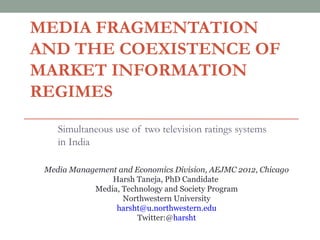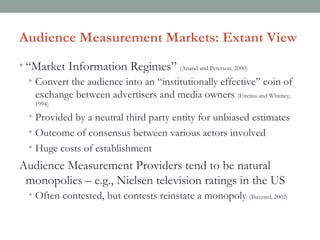Media fragmentation and the coexistence of market information
- 1. MEDIA FRAGMENTATION AND THE COEXISTENCE OF MARKET INFORMATION REGIMES Simultaneous use of two television ratings systems in India Media Management and Economics Division, AEJMC 2012, Chicago Harsh Taneja, PhD Candidate Media, Technology and Society Program Northwestern University harsht@u.northwestern.edu Twitter:@harsht
- 2. Study Overview Question: Are markets for audience measurement natural monopolies? Approach: An ethnographic study of ratings producers and consumers in a media market with two television ratings providers Contribution: Identification of conditions wherein multiple providers can exist in media markets
- 3. Audience Measurement Markets: Extant View ŌĆó ŌĆ£Market Information RegimesŌĆØ (Anand and Peterson, 2000) ŌĆó Convert the audience into an ŌĆ£institutionally effectiveŌĆØ coin of exchange between advertisers and media owners (Ettema and Whitney, 1994) ŌĆó Provided by a neutral third party entity for unbiased estimates ŌĆó Outcome of consensus between various actors involved ŌĆó Huge costs of establishment Audience Measurement Providers tend to be natural monopolies ŌĆō e.g., Nielsen television ratings in the US ŌĆó Often contested, but contests reinstate a monopoly (Buzzard, 2002)
- 4. Contests between Audience Measurement Firms Changes in Need to Adapt Audience Measurement Behavior Entry Resistance by of Compete Existing Firm (s) Competitors Single Measurement Provider Reinstated
- 5. Audience measurement industry not a natural monopoly ŌĆó Ratings markets have provided ŌĆ£opportunities for product substitutionŌĆØ (Furchtgott-Roth, Hahn, & Layne-Farrar, 2007) ŌĆó Multiple players can thrive if market participants support ŌĆó Single provider situation not attributable to market failure ŌĆó Consequences of increasing media fragmentation ŌĆó A larger subscriber pool (Taneja & Mamoria, 2012) ŌĆó Differing needs of different stakeholders ŌĆó ŌĆ£A basket of currenciesŌĆØ than a single measurement provider (Napoli, 2011)
- 6. What Has Not Been Explored? ’üĮ When data from multiple measurement systems are in circulation, how do participants make use of information from competing systems? ŌŚ” Do content and advertising functions, niche vs mass outlets etc. use ratings differently? ’üĮ Reason: Most studies focus on an institutional level of analysis ŌŚ” Need to focus at a the level of individuals and organizations who use audience information
- 7. Television Audience Measurement in India ’üĮ India has 120 million pay TV households and 650 channels ( from 1 in 1991 and 50 in 2001) ’üĮ Before 2005: Weekly Ratings by TAM ( a Nielsen Subsidiary) the only ratings service in the market ’üĮ 2005: Entry of aMAP as an overnight ratings service ’üĮ 2005 -2012: Both TAM and aMAP circulate in the market ’üĮ Systems similar on all aspects except frequency of reporting
- 8. Method: Semi Structured Interviews ’üĮ 15 Interviews with Industry Professionals ŌŚ” Programming Function ’é¢ 7 Research Managers at Broadcasters ŌŚ” Advertising Function ’é¢ 4 Media Planners and Buyers ’é¢ 1 Advertising Manager at a consumer goods company ’é¢ 2 Advertising Sales Professionals ŌŚ” Measurement Service Providers ’é¢ 2 Business Managers ( 1 each at TAM and aMAP) ’üĮ Interviews in two markets that contribute to most of the nationŌĆÖs media production as well as advertising spends
- 9. RQ1a: Which organizations subscribed to either TAM, aMAP, or both ? ’üĮ TAM unequivocally accepted as the advertising currency ŌŚ” Used by all broadcasters and advertising agencies ’üĮ aMAP used by select broadcasters in programming functions alone ŌŚ” Initial uptake by new broadcasters who used it during launch ŌŚ” Some broadcasters lapsed, others continue to use it ŌŚ” Not subscribed by majority of agencies
- 10. RQ1b: Why certain organizations subscribed to aMAP, when TAM was recognized as the sole industry currency? ’üĮ aMAP used exclusively to boost performance on TAM ŌŚ” Overnight data which helps them react faster ŌŚ” Make changes in schedules, intensify promotions ŌŚ” Have devised ratios to convert TAM to aMAP ’üĮ Other players were unable to deal with divergence; resisted a second system ŌŚ” Executives have informal access to aMAP through peers
- 11. RQ2: How did executives in programming and advertising functions use either or both TAM and aMAP in their jobs? Programming Network Advertising Trading Performance ’üĮ TAM sole system used aMAP ’üĮ Subscribers to TAM and numbers good to know aMAP ’üĮ Deals made weeks in advance ŌĆó Use aMAP to improve ’üĮ Last minute alterations not performance on TAM viable - full inventories ŌĆó Access restricted to research ’üĮ Lack of market maturity for teams dealing with daily numbers ’üĮ Subscribers to just TAM ŌĆó Gain informal access to aMAP numbers
- 12. RQ3: Did each of TAM and aMAP perceive the other as direct competitor ? ŌĆó TAM and aMAP did not perceive each other as competitors, but as complements ŌĆó TAM viewed aMAP as a complementary system that broadcasters used as an additional research tool ŌĆó Saw no need to convert to an overnight ratings regime ŌĆó aMAP saw newer opportunities in Set Top Box based measurement as market was digitizing fast
- 13. Discussion: Coexistence of Audience Measurement Providers 1.Market fragmentation catalyzed the entry of a parallel system 2.Market supported multiple audience measurement systems as they met different stakeholder needs ŌĆó Advertising currency not the sole use of ratings 3.Systems differentiated on dimensions other than method of data collection ŌĆó Frequency of reporting in this case
- 14. Conclusion ’üĮ Highly fragmented markets can support multiple audience measurement systems if they serve distinct institutional interests
- 15. QUESTIONS AND COMMENTS Harsh Taneja, PhD Candidate Media, Technology and Society Program Northwestern University harsht@u.northwestern.edu














